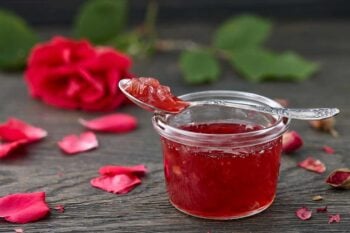Once your baby is at least 6 months in age, it is time to introduce some solid foods. But, have you ever looked on the back of a jar of baby food or a box of rice cereal? Yikes!
The first thing you may notice is added modified starches, sugars, corn syrup, and other additives—even in the organic ones. Your baby certainly doesn’t need any of these things, and some could even be outright harmful.
The Dirty Secret About Baby Food
The second thing you may notice after reading the ingredients is that there is almost no nutrition in jars of baby food or boxes of rice cereal—again, even in the organic ones. With the exception of a little added Vitamin A or C, packaged baby foods have nothing to offer your little one except mush to fill the tummy.
Lastly, what you cannot see (and what is not on the label), are the arsenic, pesticide, herbicide, BPA, GMOs and other toxic chemical residues that were part of growing and processing the food in the jar. These hidden ingredients have no place anywhere near your baby!
This article contains affiliate links. As an Amazon Associate I earn from qualifying purchases.
Making Your Own Baby Food is Healthy, Easy and Affordable
The good news is that making your own baby food is very, very easy, and is one of the best ways to ensure the quality of nutrition your child gets for healthy growth and development.
It’s also very inexpensive, compared to baby food you buy in the store, and requires no resource-intensive packaging or shipping to the store.
In fact, making your own healthy baby food can save you over $600 a year! And you can feel really good knowing that you avoided using and polluting all the natural resources that go into packaging, shipping and disposing of store-bought baby food.
On the weekend or during regular dinner cooking, simply separate out some of the organic food you are already eating (or leave it raw, depending), blend in a food processor or blender, then freeze the purée in non-toxic, silicone or stainless steel ice cube trays.
Make sure whatever you are saving isn’t too spicy, but a little seasoning teaches your child to appreciate normal food (rather than special “kid food”) right from the start.
Once the foods are frozen, pop them out of the trays and put them in a freezer-safe glass container to keep them from getting freezer burn. Thaw and reheat a cube or two for each meal.
Better Baby Food Options for When You’re Short on Time
If you just don’t have the time or inclination to make your baby food, many brands of organic baby food are now available. Some of these brands are in the freezer section, and are made from fresh produce that’s minimally processed, which maintains more of the original flavor, color, and nutrient content than the jarred stuff.
Some of these companies also use eco-friendly packaging such as recycled cardboard, vegetable inks, and BPA-free plastic. Some brands include:
Baby-Led Weaning – The Easiest, Cheapest Way to Feed Your Baby

The easiest, cheapest, and most natural, low-impact way to feed your baby is a technique called “Baby-Led Weaning.”
Practiced throughout the world, baby-led weaning is a way of introducing solid foods that allows the baby to feed herself—there’s no spoon-feeding and no purées. (Phew!)
Your baby sits with the rest of the family at mealtimes, and joins in when she is ready. You offer her food in sizes, shapes and textures that she can handle, and she feeds herself with her fingers, choosing what to eat, how much and how quickly.
Gradually, your baby eats more and more solid foods and less and less breastmilk or formula, according to their own unique developmental timeline.
This is how babies were traditionally weaned in many cultures, before the advent of the “Gerber baby.”
Finger-sized “sticks” of organic, steamed carrots, skinned zucchini, apple, avocado, or pear, or even bits of hormone-free, grassfed ground beef, hard-boiled egg, or minced chicken are perfect, highly nutritious first foods when doing baby-led weaning.
And, if you’re not too grossed out by the idea, you can even pre-chew some tougher foods and offer them to your baby. The enzymes on the food from your mouth actually help her digest them better!
This is the way we introduced solid foods to our baby with great success. Her first foods were homemade hummus, fresh strawberries, and liver!
All healthy babies can eat soft, solid foods, even without teeth; they just need to be given the opportunity to feed themselves. I mean, would you want to be strapped into a high chair and force-fed spoon after spoon of bland vegetables?
It’s surely much more exciting to be able to exercise a bit of control over your diet and share in a bit of what mom and dad are having. And it’s so much easier on parents too!








